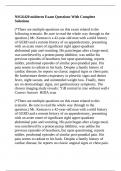NSG6420 midterm Exam Questions With Complete
Solutions
(*There are multiple questions on this exam related to the
following scenario. Be sure to read the whole way through to the
question.) Mr. Keenan is a 42-year-old man with a mild history
of GERD and a remote history of an appendectomy, presenting
with an acute onset of significant right upper-quadrant
abdominal pain and vomiting. His pain began after a large meal,
was unrelieved by a proton-pump inhibitor, was unlike his
previous episodes of heartburn, but upon questioning, reports
milder, prodromal episodes of similar post-prandial pain. His
pain seems to radiate to his back. Despite a family history of
cardiac disease, he reports no classic anginal signs or chest pain.
He furthermore denies respiratory or pleuritic signs and denies
fever, night sweats, and unintended weight loss. Finally, there
are no dermatologic signs, nor genitourinary symptoms. The
chosen imaging study reveals: "GB normal in size without wall-t
Correct Answer HIDA scan
(*There are multiple questions on this exam related to this
scenario. Be sure to read the whole way through to the
question.) Mr. Keenan is a 42-year-old man with a mild history
of GERD and a remote history of an appendectomy, presenting
with an acute onset of significant right upper-quadrant
abdominal pain and vomiting. His pain began after a large meal,
was unrelieved by a proton-pump inhibitor, was unlike his
previous episodes of heartburn, but upon questioning, reports
milder, prodromal episodes of similar post-prandial pain. His
pain seems to radiate to his back. Despite a family history of
cardiac disease, he reports no classic anginal signs or chest pain.
,He furthermore denies respiratory or pleuritic signs and denies
fever, night sweats, and unintended weight loss. Finally, there
are no dermatologic signs, nor genitourinary symptoms. Of the
following lab studies, which would provide little help in
determining Correct Answer urinalysis
4 Dan G., a 65-year-old man, presents to your primary care
office for the evaluation of chest pain and left-sided shoulder
pain. Pain begins after strenuous activity, including walking.
Pain is characterized as dull, aching; 8/10 during activity,
otherwise 0/10. Began a few months ago, intermittent,
aggravated by exercise, and relieved by rest. Has occasional
nausea. Pain is retrosternal, radiating to left shoulder, definitely
affects quality of life by limiting activity. Pain is worse today;
did not go away after he stopped walking. BP 120/80. Pulse 72
and regular. Normal heart sounds, S1 and S2, no murmurs.
Which of the following differential diagnoses would be most
likely? Correct Answer coronary artery disease with angina
pectoris
85 (*There are multiple questions on this exam related to the
following scenario. Be sure to read the whole way through to the
question.) Mr. Keenan is a 42-year-old man with a mild history
of GERD and a remote history of an appendectomy, presenting
with an acute onset of significant right upper-quadrant
abdominal pain and vomiting. His pain began after a large meal,
was unrelieved by a proton-pump inhibitor, was unlike his
previous episodes of heartburn, but upon questioning, reports
milder, prodromal episodes of similar post-prandial pain. His
pain seems to radiate to his back. Despite a family history of
cardiac disease, he reports no classic anginal signs or chest pain.
, He furthermore denies respiratory or pleuritic signs and denies
fever, night sweats, and unintended weight loss. Finally, there
are no dermatologic signs, nor genitourinary symptoms. When
all lab work is returned within normal limits, what is the
Correct Answer abdominal ultrasound
A 20-year-old engineering student complains of episodes of
abdominal discomfort, bloating, and episodes of diarrhea. The
symptoms usually occur after eating, and pain is frequently
relieved with bowel movement. She is on a "celiac diet" and the
episodic symptoms persist. Physical examination and diagnostic
tests are negative. Colonoscopy is negative for any
abnormalities. This is a history and physical consistent with:
Correct Answer irritable bowel syndrome
A 22-year-old female comes to your office with complaints of
right lower quadrant abdominal pain, which has been worsening
over the last 24 hours. On examination of the abdomen, there is
a palpable mass and rebound tenderness over the right lower
quadrant. The clinician should recognize the importance of:
Correct Answer pelvic examination
A 23-year-old patient who has had bronchiectasis since
childhood is likely to have which of the following: Correct
Answer clubbing
A 24-year-old patient presents to the emergency department
after sustaining multiple traumatic injuries after a motorcycle
accident. Upon examination, you note tachypnea, use of
intercostal muscles to breathe, asymmetric chest expansion, and




